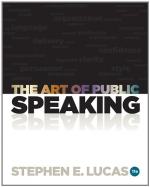—J.B.E., How to Attract and Hold an Audience.
There are four fundamental methods of delivering an address; all others are modifications of one or more of these: reading from manuscript, committing the written speech and speaking from memory, speaking from notes, and extemporaneous speech. It is impossible to say which form of delivery is best for all speakers in all circumstances—in deciding for yourself you should consider the occasion, the nature of the audience, the character of your subject, and your own limitations of time and ability. However, it is worth while warning you not to be lenient in self-exaction. Say to yourself courageously: What others can do, I can attempt. A bold spirit conquers where others flinch, and a trying task challenges pluck.
Reading from Manuscript
This method really deserves short shrift in a book on public speaking, for, delude yourself as you may, public reading is not public speaking. Yet there are so many who grasp this broken reed for support that we must here discuss the “read speech”—apologetic misnomer as it is.
Certainly there are occasions—among them, the opening of Congress, the presentation of a sore question before a deliberative body, or a historical commemoration—when it may seem not alone to the “orator” but to all those interested that the chief thing is to express certain thoughts in precise language—in language that must not be either misunderstood or misquoted. At such times oratory is unhappily elbowed to a back bench, the manuscript is solemnly withdrawn from the capacious inner pocket of the new frock coat, and everyone settles himself resignedly, with only a feeble flicker of hope that the so-called speech may not be as long as it is thick. The words may be golden, but the hearers’ (?) eyes are prone to be leaden, and in about one instance out of a hundred does the perpetrator really deliver an impressive address. His excuse is his apology—he is not to be blamed, as a rule, for some one decreed that it would be dangerous to cut loose from manuscript moorings and take his audience with him on a really delightful sail.
One great trouble on such “great occasions” is that the essayist—for such he is—has been chosen not because of his speaking ability but because his grandfather fought in a certain battle, or his constituents sent him to Congress, or his gifts in some line of endeavor other than speaking have distinguished him.




